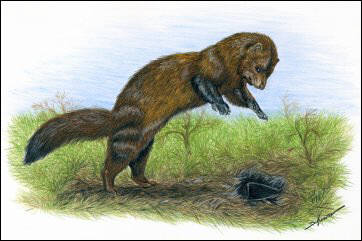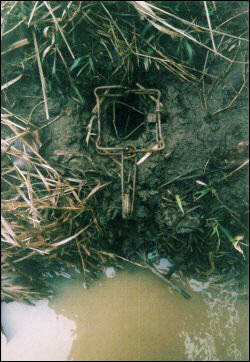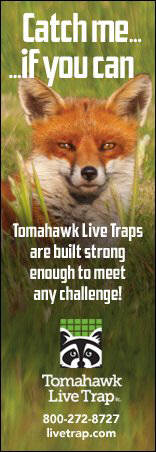


Copyright©2011-25 by Trapper's Post - All Rights Reserved
Website by Hawk Mountain Designs
Sample Articles
TRAPPER'S POST
Exclusively Trapping
September/October 2013 issue


Trapper's Post
Article Archives
The first vertical hole I can remember setting a trap at was a natural opening in the ice on a ditch I was trapping as a kid. I had noticed openings in the ice like this many times before, but this one stuck out and made me think about it. There were fresh mink tracks in the snow and on the ice around the hole, plus a few drops of blood and some fish scales. The mink had been hunting for food under the ice. I decided to set a #110 bodygrip flat over the hole. I laid some cattail stems and black willow twigs on the ice outside the opening of the hole to support the set trap and spring, and keep them from freezing into the ice. I chipped a small hole in the ice for the dog to point down into, as I feared something might snag the dog, and misfire the trap, if it was left pointing up. I wired the trap chain to a black willow and used some cattail stalks and stems to cover the wire and chain. The stark blackness of the dyed trap jaws and spring against the snow and ice bothered me, so I cut off a bunch of cattail heads and stacked them alongside and over the spring, then dusted some snow over them. I couldn’t figure out how to cover the trap jaws without causing problems with the trap firing, or causing it to freeze, so I just left them uncovered. I spread the trigger wires into a wide V shape, which covered the opening better. It looked kind of crude even to me as a 12-year-old, but I’d done the best I could. I wasn’t convinced it would catch anything, let alone a mink.


The most consistently productive of any of the natural vertical holes I set, were the ones going into a muskrat den or into a root system. I caught a lot of bank running mink going down into those holes, and about half as many coming out. I caught an equal amount of muskrats going either way.At no point did I use any lure or bait; I left them as natural blind sets. I knew if I added any lure or bait I’d start having raccoons springing the #110-size bodygrips, tearing up the set, and pulling out of the trap. Also I’d catch more skunks and possums.
Most of these natural holes were only useable for one trapping season, and some were only useable for a very short time during the season, because of weather (ice, snow, freeze/thaw, rain/flooding, etc.), but also because of the damage done to the site by trapped animals.
Although these natural locations were valuable, finding them was hit and miss at best, and they didn’t last. I decided to try digging my own vertical holes (or as I now call them, vertical pocket sets), which would allow me to make them anywhere I needed one, instead of just infrequently finding a natural one.
The first vertical pocket set I made on purpose was born out of my frustration at not being able to make any other mink sets at one particular location. The creek bank was fairly flat, level, and mostly featureless, with short vegetation for cover. There was only about 6 inches or less of frontal bank edge above the normal water level, and the bank was made of very soft material. I could find no trails up on the bank or at the bank’s edge for blind sets, and the softness of the bank wouldn’t allow digging a pocket into it horizontally without caving in.
The top of the bank reminded me of many I had set where vertical cave-in holes led into muskrat dens, so I decided to basically just mock up that type of set. With my shovel I dug a hole straight down, about 2 feet back from the water’s edge, about 4 inches in diameter, and about 18 inches deep, even though I hit ground water level at 6 inches, the same level as the creek surface. I wanted the mink to think the hole really went somewhere. I then laid a set #110 bodygrip on the bank with the hole centered inside the set jaw area, and with the spring pointed towards the water.
I marked the area around the set trap with my shovel, removed the trap, and dug out that area as a bed for the trap to lay in, so the jaws were just below ground level. I laid short pieces of small diameter sticks in the corners of the bed for the trap to rest on, instead of laying directly on the dirt/mud. This would keep the trap jaws from freezing down. I also dug out a trench for the spring, to lie in below ground level. I put some sticks in the bottom of this trench to keep the spring from freezing down. With my finger I poked a hole much larger than needed for the end of the trap’s dog to point down into, so it would be out of the way.
Through trial and error I’d found this was the best way, as I’d had animals spring the trap by bumping the end of the dog if it was left pointing up. I always make sure the hole for the dog is large enough for it to freely move far enough for the trap to fire. I added wire to the trap’s chain ring and staked it out in the water, so a mink or muskrat would flop off the bank into the water, out of sight of predators. I blended in the trap and spring by covering it with pieces of grass and weeds from the bank, leaving a 3-inch or so opening in the center of the jaw area, directly over the vertical hole.
Looking down at the set, I could see reflections off the water down in the hole. I surmised a mink would see that as well, which would add to the set’s effectiveness. I was pleased with my work, the set looked real natural. The next day it held a nice large male mink. It had flopped out into the water just as I had wanted.
I made several more sets in that area scattered up and down the bank farther away, but that first one ending up taking four more mink, seven muskrats, and a skunk. It was tripped a few times by raccoons, probably attracted by the smell of the other catches as I never used lure or bait.

The next day I found fresh mink tracks in the snow on the ice coming right up to the set, pausing, then going on past it. Apparently the mink didn’t like what it saw around the hole. But two days later I caught a mink in that set. coming out from under the ice. This was followed by another mink the next day, this one caught trying to go under the ice through the hole from above. I also caught several muskrats over the next week, all coming out from under the ice.
By now the set was no longer useable due to damage from the catches, but it had proved its worth, and taught me a lot. After that I started setting a wide variety of natural vertical holes, just about any I could find. Holes up on the bank where something had dug open a muskrat den, or it had caved in at a weak spot; holes washed open, dug open, or caved in into root systems below; holes down into beaver dams, muskrat huts, and riprap; blowouts down into or along a tile; and of course any holes going down through the ice. I did find some vertical holes in deep snow after a blizzard, made by mink tunneling under the snow to get in and out of dens they’d spent the storm in. These produced several mink even when it was well below zero.
When BMI Magnum #110s came out I bought a lot of them to use both in trail sets and in this type of set, as the jaws close tighter, and I like the trigger better. But any #110 size trap will work. If I lived where I could use a 6-inch bodygrip trap on land I would try this type of set with a #160, baited and lured for raccoons. I also think this would work as an otter set, with the larger bodygrips where legal. It has worked well for me primarily as a mink set, but where ample muskrat populations occur you’re going to catch some of them as well.
The author is an Ohio ADC and fur trapper with many years experience.

Home | Subscribe | Shop | Books & Videos | Advertise | Past Issues | Photos | Articles | Links | Associations | Testimonials | Guidelines | TP Staff | Contact Us






Trapper's Post
Article Archives






Trapper's Post
P.O. Box 128, Scandinavia, WI 54977
Phone: 715-445-2540 Email: office@trapperspost.com


